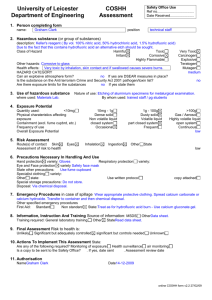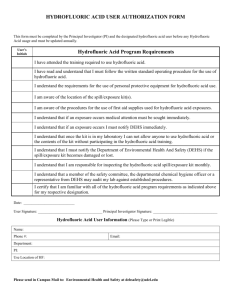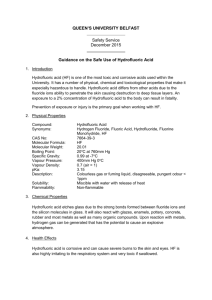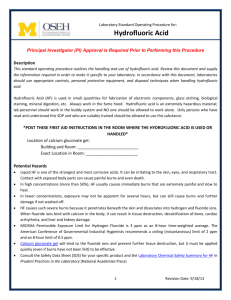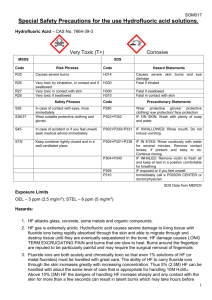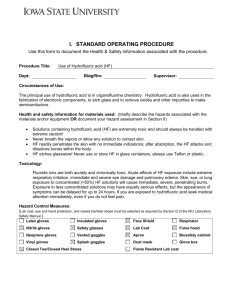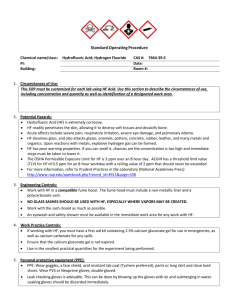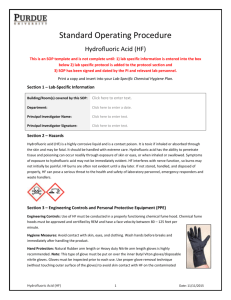Microsoft Word Document
advertisement
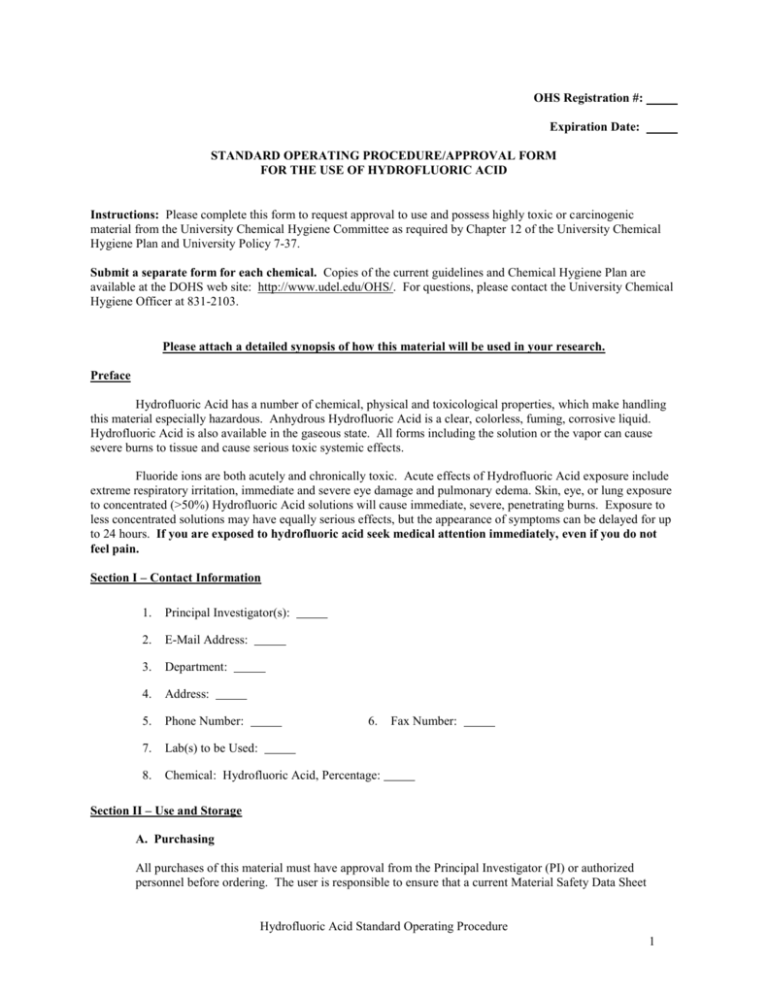
OHS Registration #: Expiration Date: STANDARD OPERATING PROCEDURE/APPROVAL FORM FOR THE USE OF HYDROFLUORIC ACID Instructions: Please complete this form to request approval to use and possess highly toxic or carcinogenic material from the University Chemical Hygiene Committee as required by Chapter 12 of the University Chemical Hygiene Plan and University Policy 7-37. Submit a separate form for each chemical. Copies of the current guidelines and Chemical Hygiene Plan are available at the DOHS web site: http://www.udel.edu/OHS/. For questions, please contact the University Chemical Hygiene Officer at 831-2103. Please attach a detailed synopsis of how this material will be used in your research. Preface Hydrofluoric Acid has a number of chemical, physical and toxicological properties, which make handling this material especially hazardous. Anhydrous Hydrofluoric Acid is a clear, colorless, fuming, corrosive liquid. Hydrofluoric Acid is also available in the gaseous state. All forms including the solution or the vapor can cause severe burns to tissue and cause serious toxic systemic effects. Fluoride ions are both acutely and chronically toxic. Acute effects of Hydrofluoric Acid exposure include extreme respiratory irritation, immediate and severe eye damage and pulmonary edema. Skin, eye, or lung exposure to concentrated (>50%) Hydrofluoric Acid solutions will cause immediate, severe, penetrating burns. Exposure to less concentrated solutions may have equally serious effects, but the appearance of symptoms can be delayed for up to 24 hours. If you are exposed to hydrofluoric acid seek medical attention immediately, even if you do not feel pain. Section I – Contact Information 1. Principal Investigator(s): 2. E-Mail Address: 3. Department: 4. Address: 5. Phone Number: 7. Lab(s) to be Used: 8. Chemical: Hydrofluoric Acid, Percentage: 6. Fax Number: Section II – Use and Storage A. Purchasing All purchases of this material must have approval from the Principal Investigator (PI) or authorized personnel before ordering. The user is responsible to ensure that a current Material Safety Data Sheet Hydrofluoric Acid Standard Operating Procedure 1 (MSDS) is obtained unless a current one is already available within the laboratory. Quantities of this material will be limited to , and/or the smallest amount necessary to complete the experiment. B. Authorized personnel Please select the general categories of personnel who could obtain approval to use this material. Undergraduate students are prohibited to use or handle Hydrofluoric Acid: 1. Principal Investigator 2. 4. Post Doctoral Employees Graduate Students 5. 3. Technical Staff Other (Describe): Please list the specific personnel and their approval level (Attach an addendum to this form for additional personnel): NOTE: The Principal Investigator must be aware of all purchases of this material. The Principal Investigator must assure the there is not an exceedance of the quantity limits. All personnel must be authorized by the Principal Investigator and have a Hydrofluoric Acid User Authorization Form on file with OHS. This form can be found at http://www.udel.edu/OHS/hfsafety.html 1. Purchase Use the Material 2. Purchase Use the Material 3. Purchase Use the Material 4. Purchase Use the Material 5. Purchase Use the Material The Principal Investigator will update this section when any personnel changes occur. If changes occur, document the changes (include the record of training of additional personnel) in the laboratory’s files and submit an addendum to the University Chemical Hygiene Officer with all training documentation. C. Storage Materials will be stored according to compatibility and label recommendations in a designated area. 1. Please list compounds that this chemical is incompatible with: 2. Material is corrosive to most metals and glass. Segregate from alkalis, oxidizing agents and chemicals readily decomposed by acids, i.e. cyanides, sulfides, carbonates and metal oxides. Segregate for organic materials including solvents, flammable liquids and organic acids (acetic acid, formic acid, etc.) Other: Please list special storage requirements (I.E.: Refrigerated, Inert Atmosphere, Desiccated, etc.): Avoid storage with glass, cement, concrete and other silicon materials; reaction produces toxic silicon tetrafluoride gas; which may pressurize and/or rupture containers. Keep dry and DO NOT use unlined steel containers DO NOT use aluminum, galvanized or tin-plated containers Hydrofluoric Acid Standard Operating Procedure 2 3. It will also attack glazes, enamels, pottery, concrete, rubber, leather, many metals (especially cast iron) and organic compounds. Upon reaction with metals, explosive hydrogen gas may be formed. Use and store Hydrofluoric Acid in polyethylene, polypropylene, Teflon, wax, lead or platinum containers. Other: Please list specific storage area (This Area Must be Marked and Labeled): Storage areas will be inspected by laboratory personnel on a regular basis. Personnel will check for safety concerns such as improper storage, leaking/damaged container(s), damaged labels, quantities in excess of approved limits, theft/disappearance of material, etc. The inspector will also determine if an inventory reduction is possible. The Principal Investigator will designate one individual to complete this inspection. 4. Please select an inspection frequency: Weekly Biweekly Monthly Bimonthly D. Use location: Materials shall be used only in the following designated areas. Check all that apply: 1. Fume Hood 2. 3. Other (Describe): Glove Box Section III – Personnel Safety and Protection A. Training requirements: All users must demonstrate competency and familiarity regarding the safe handling and use of this material prior to purchase. The Principal Investigator is responsible for maintaining the training records for each user of this material. Training should include the following: 1. All users and laboratory personnel working with or in laboratories where Hydrofluoric Acid is stored and/or used must attend the Occupational Health and Safety’s Hydrofluoric Acid Safety Training annually. A web based refresher training is also offered. 2. Chemical Waste Disposal Training. Courses are offered by DOHS and online through WebCT. 3. Chemical Hygiene Plan/Right-To-Know 4. Review of current MSDS 5. Review of the OSHA Lab Standard 6. Review of the Chemical Hygiene Plan 7. Special training provided by the department/supervisor (Right to Know) 8. Review of the departmental safety manual if applicable Hydrofluoric Acid Standard Operating Procedure 3 9. Safety meetings and seminars 10. One-on-One hands-on training with the Principal Investigator or other knowledgeable laboratory personnel. 11. Other: B. Personal Protective Equipment: All personnel are required to wear the following personal protective equipment whenever handling this material: 1. Proper Laboratory Attire a. b. c. d. A long-sleeved shirt Buttoned lab coat with elastic cuffs Pants or long skirt Closed-toe, non-perforated (no sneakers) shoes. 2. Chemical Splash Goggles 3. Face Shield 4. Chemical Protective Gloves (Hydrofluoric Acid burns around the fingernails are extremely painful, difficult to treat, and may require surgical removal of the nail). a. 22 mil Stanzoil Neoprene or 22 mil Stanzoil Nitrile Gloves Personnel may be required to wear other Personal Protective Equipment when working with this material. The Principal Investigator should contact the University Chemical Hygiene Officer to discuss the selection of chemical protective clothing (aprons, suits) and respirators. Please check all that apply: 1. 2. Chemical Protective Clothing (Describe): Chemical Protective Splash Apron (Describe): Butyl Rubber Splash Apron as appropriate, usually for waste disposal activities 3. Respirator (Type): 4. Other (Describe): C. Safe Work Practices The following safe work practices should be employed when using this material: 1. Wear all required personal protective equipment 2. Cover open wounds 3. Wash hands thoroughly when work with the material is completed 4. No mouth pipetting Hydrofluoric Acid Standard Operating Procedure 4 5. Use of sharps, such as glass Pasteur pipettes, needles, razor blades, etc. should be avoided or minimized 6. Do not use the material in a wash bottle. 7. Laboratories which keep or use Hydrofluoric Acid gas or concentrated solutions must have an operational safety shower and eye wash in their physical laboratory space. 8. Before beginning any procedure involving Hydrofluoric Acid, make sure the access to the emergency shower and eyewash is unobstructed. 9. Must not work alone in the laboratory, a trained buddy (in Hydrofluoric Acid Safety) must be present in the area where the work is occurring. The buddy system must be implemented whenever using Hydrofluoric Acid. 10. Everyone working with Hydrofluoric Acid must be properly trained on the appropriate waste management steps, including elementary neutralization. 11. Everyone working with or around Hydrofluoric Acid must have the University Hydrofluoric Acid Safety training before commencing any work and an annual refresher training thereafter. 12. Do not breathe mist and vapor. 13. Observe manufacturer's storage and handling recommendations. 14. WARNING: To avoid violent reaction, ALWAYS add material to water and NEVER water to the material. 15. DO NOT eat, drink or smoke in the laboratory. 16. Keep containers securely sealed when not in use. 17. Work with Hydrofluoric Acid can only occur Monday through Friday, 8:00 am until 5:00 pm. Must not work with the materials after hours. 18. Do not wear contact lenses; utilize prescription glasses under the slash goggles or splash goggles outfitted with a prescription insert. 19. Any exposure to Hydrofluoric Acid must be medically evaluated 20. No hydrofluoric acid work is to be conducted outside of a properly operating fume hood that has a current certification sticker. 21. All work must be conducted in a secondary container inside the chemical fume hood. Work in a fume hood with the sash as low as possible. 22. A sign should be posted to alert people that work with Hydrofluoric Acid is in progress. 23. Every laboratory where Hydrofluoric Acid is stored or used must have a complete Hydrofluoric Acid Spill/Exposure Kit. Occupational Health and Safety initially provides this kit and inspects it once a year when OHS replaces the expired calcium gluconate gel and calcium carbonate tablets. It is the laboratories responsibility to inspect this kit prior to beginning work with Hydrofluoric Acid for the day or at least monthly. The kit contains the following: a. Container of calcium gluconate gel. Hydrofluoric Acid Standard Operating Procedure 5 b. c. d. e. f. g. i. This gel can be obtained from Occupational Health & Safety only after completing the required training. This gel must be inspected before each use of Hydrofluoric Acid or at least monthly to ensure the gel has not been removed or has not reached the expiration date. If a tube of the gel has been opened, it must be replaced. Contact DOHS to obtain a new tube. The old container must go through the DOHS hazardous waste program. No work with HF can be done with an expired tube of calcium gluconate gel. 2 pairs of Stanzoil Neoprene or Stanzoil Nitrile (22mil) gloves. 1 heavy-duty polyethylene bag to be used for items contaminated by Hydrofluoric Acid. 1 DOHS Orange Chemical Waste Label. Copy of these procedures and up to date Material Safety Datasheet (MSDS) to take to the emergency room. Copy of the Recommended Medical Treatment for Hydrofluoric Acid Exposure Guidebook, provided by Honeywell to take to the emergency room. 1 Roll of Calcium Carbonate (antacid tablets). 24. Please list any other safe work practices: D. Personnel Decontamination For most exposures, decontamination should occur as follows: 1. General Procedures for All Exposures a. b. c. d. e. f. 2. Small Skin Exposures – a. b. c. d. e. f. g. h. i. 3. Activate buddy system response Immediately The buddy must help the injured person to the safety, eyewash or sink, as appropriate The buddy must not exposure him/herself The buddy contacts 911 (9-911 for Georgetown) Let Public Safety know you have a Hydrofluoric Acid exposure and give the exact location. Instruct them send an ambulance and notify the hospital of person in transport The buddy gets the Hydrofluoric Acid Spill/Exposure Kit and provides the calcium gluconate gel and calcium carbonate tablets when appropriate. The buddy locates and helps the exposed person the nearest clean laboratory sink Turn on the water and rinse the area Rinse area while removing all contaminated clothing for up to 5 minutes Victim should remove all contaminated items (i.e. clothing, shoes and jewelry while under the water) Victim should self administer calcium gluconate, apply the gel onto the effected area and thoroughly rub the gel into the skin: i. if the victim is unable to administer, the buddy can assist using the neoprene gloves ii. NOTE THE TIME OF INITIAL APPLICATION (may need to apply every 20 minutes until pain subsides or reach medical facility) Take 6 Calcium Carbonate tablets (TUMS) if conscious Inform Emergency Medical Personnel that calcium carbonate and calcium gluconate have been administered Buddy should bag all contaminated clothing and supplies (USE PPE) Notify OHS Eye Exposure – a. The buddy locates and helps the exposed person the eyewash station Hydrofluoric Acid Standard Operating Procedure 6 b. c. d. e. f. g. 4. Large Body Area Exposure – a. b. c. d. e. f. g. h. i. 5. Activate the eyewash. Rinse the eyes and face under the eyewash for 15 minutes – holding lids open (both lower and upper) for irrigation. Conduct this process for both liquid or vapor contamination Victim should self administer calcium gluconate, apply the gel to any effected skin areas and thoroughly rub the gel into the skin. Do not apply the gel to the eyes: i. if the victim is unable to administer, the buddy can assist using the neoprene gloves ii. NOTE THE TIME OF INITIAL APPLICATION (may need to apply every 20 minutes until pain subsides or reach medical facility) Take 6 Calcium Carbonate tablets (TUMS) if conscious Inform Emergency Medical Personnel that calcium carbonate and calcium gluconate have been administered Buddy should bag all contaminated clothing and supplies (USE PPE) Notify OHS The buddy locates and helps the exposed person the emergency safety shower Stand under shower and turn it on Rinse whole body while removing all contaminated clothing for up to 5 minutes. Victim should remove all contaminated items (i.e. clothing, shoes and jewelry while under the shower) Remove goggles last, face water and pull over head Victim should self administer calcium gluconate, apply the gel onto the effect area and thoroughly rub the gel into the skin: i. if the victim is unable to administer, the buddy can assist using the neoprene gloves ii. NOTE THE TIME OF INITIAL APPLICATION (may need to apply every 20 minutes until pain subsides or reach medical facility) Take 6 Calcium Carbonate tablets (TUMS) if conscious Inform Emergency Medical Personnel that calcium carbonate and calcium gluconate have been administered Buddy should bag all contaminated clothing and supplies (USE PPE) Notify OHS Inhalation Exposure – a. b. Immediately remove the victim to clean air if it is safe to do so The procedures for large skin or eye exposure must then be followed based on the exposure circumstances. If a vapor exposure occurs to the face, follow the procedures for an eye exposure. If a vapor exposure occurs to the chest of body, follow the procedures for a large skin exposure. E. Exposure Symptoms 1. Skin Exposure Symptoms: Skin contact with the material may produce severely toxic effects; systemic effects may result following absorption and these may be fatal. The material can produce severe chemical burns following direct contact with the skin. Bare unprotected skin should not be exposed to this material. Solutions of hydrofluoric acid, as dilute as 2%, may cause severe skin burns. Fluorides are easily absorbed through the skin and cause death of soft tissue and erode bone as well as cause cardiac arrhythmias or cardiac arrest. Healing is delayed and death of tissue may continue to spread beneath skin. 2. Eye Contact Symptoms: The material can produce severe chemical burns to the eye following direct contact. Vapors or mists may be extremely irritating. If applied to the eyes, this material causes severe eye damage. The vapor may produce pronounced discomfort of Hydrofluoric Acid Standard Operating Procedure 7 the eyes when present at higher concentrations and this generally gives warning of excessive exposure and the need for control measures to ensure safe working conditions. Fluorides are easily absorbed through the skin and cause death of soft tissue and erode bone as well as cause cardiac arrhythmias or cardiac arrest. 3. Ingestion Symptoms: Severely toxic effects may result from the accidental ingestion of the material; animal experiments indicate that ingestion of less than 5 gram may be fatal or may produce serious damage to the health of the individual. The material can produce severe chemical burns within the oral cavity and gastrointestinal tract following ingestion. Fluorides are easily absorbed through the skin and cause death of soft tissue and erode bone as well as cause cardiac arrhythmias or cardiac arrest. 4. Inhalation Symptoms: If inhaled, this material can irritate the throat and lungs of some persons. Acute effects of fluoride inhalation include irritation of nose and throat, coughing and chest discomfort. A single acute over-exposure may even cause nose bleed. Pre-existing respiratory conditions such as emphysema, bronchitis may be aggravated by exposure. Occupational asthma may result from exposure. Fluorides are easily absorbed through the skin and cause death of soft tissue and erode bone as well as cause cardiac arrhythmias or cardiac arrest. The ChemWatch MSDS, which is available at http://www.udel.edu/OHS/ oftentimes, has treatment information for Emergency Room Personnel and Doctors to follow. Please list any information that can be provided to assist with the treatment: Complete treatment recommendations and guidelines can be found in the Recommended Medical Treatment for Hydrofluoric Acid Exposure Guidebook, provided by Honeywell. This will be brought to the Emergency Room by the Laboratory Personnel. 1. 2. 3. 4. 5. 6. 7. 8. 9. Considered toxic by all exposure routes. Principal routes of exposure are usually by skin contact, eye contact with the material and inhalation of vapor. Hydrogen fluoride easily penetrates the skin and causes destruction and corrosion of the bone and underlying tissue. Ingestion causes severe pains and burns in the mouth and throat and blood calcium levels are dangerously reduced. Symptoms include spasm and twitching of the muscles, high fever, convulsions and general extreme pain. Inhalation may cause corrosion of the throat, nose and lungs, leading to severe inflammation and lung swelling. Extended exposure to inorganic fluorides causes fluorosis, which includes signs of joint pain and stiffness, tooth discoloration, nausea and vomiting, loss of appetite, diarrhea or constipation, weight loss, anemia, weakness and general sickness There may also be frequent urination and thirst. Redness, itchiness and allergy-like inflammation of the skin and mouth cavity can occur. The central nervous system may be involved. Fluorides are easily absorbed through the skin and cause death of soft tissue and erode bone as well as cause cardiac arrhythmias or cardiac arrest. F. Spills Notify OHS of any spills. OHS is responsible for all Hydrofluoric Acid spill clean ups. If a spill is large or occurs outside of a fume hood, the laboratory occupants should immediately vacate the laboratory, close all doors and contact Occupational Health & Safety at 831-8475 during working hours or 911 after hours. If the laboratory personnel determine that the spill is not contained to the lab or could cause harm to people outside the laboratory, they should pull the building fire alarm and go to the Emergency Gathering Point to await the University Police and Emergency Responders. The Hydrofluoric Acid Standard Operating Procedure 8 responsible/knowledgeable person should provide the University Police and the Emergency Responders with the following: 1. Common Name of the Material Involved 2. A copy of a MSDS, if possible 3. Any pertinent information related to the emergency, such as location in the lab, other hazards in the lab, etc. G. Emergency Phone Numbers: Below are a list of emergency numbers to contact in the event of an emergency: 1. Police, Fire or Medical Emergency, call – 911 on the Newark Campus, 9-911 for all others 2. Occupational Health & Safety – 302-831-8475 Please provide a list of other emergency phone numbers, such as after hour contacts for laboratory personnel or any other important phone number, to be used in the event of an emergency: H. Other Special precautions Please list any other special precautions or procedures not listed in the above sections. Please be as specific as possible: Section VI – Waste Disposal The authorized person using this material is responsible for the safe collection, preparation and proper disposal of waste unless otherwise stated below. Waste shall be disposed of as soon as possible and in accordance with all laboratory and University procedures. All personal must obtain chemical waste disposal training via DOHS. OHS prefers that laboratory personnel neutralize hydrofluoric acid waste prior to disposal by the Waste Management Staff. Laboratory personnel must strictly adhere to the following procedure. OHS must be present the first time a neutralization procedure is performed. Elementary Neutralization of Hydrofluoric Acid Waste 1. 2. 3. 4. 5. 6. 7. 8. Must wear appropriate personal protective equipment a. Splash Goggles b. Face Shield c. 22 mil Neoprene Gloves d. Lab Coat e. Chemical Splash apron Perform the neutralization in a fume hood Obtain a funnel and a 2 ½ to 5 gallon high-density polyethylene pail or container. Place the container is secondary containment. Fill container half way with cold water Slowly add Hydrofluoric Acid to the water. This will minimize the splash hazard. Do not add more than 500 ml at a time. Repeat this process if you need to neutralize more than 500 ml Take the pH of the mixture. If pH is not neutral, slowly add Calcium Carbonate to the container until the mixture is neutral. Only Hydrofluoric Acid that is not contaminated with any metals may be sewer disposed. Contaminated neutralized solutions must be disposed of through the chemical waste program. All aspects of the Chemical Hydrofluoric Acid Standard Operating Procedure 9 Waste Program must be followed. Label the container with an orange DOHS hazardous waste label and submit a chemical waste pick up request. 9. If the solution is not contaminated and a pH of seven is obtained, slowly decant liquid into the sanitary sewer. Run 50 volumes of cold water down the drain. 10. Collect any solid precipitate that may form and dispose of through the chemical waste program. This solid material cannot go down the drain or into the trash. Use a screen or sieve and a sturdy polyethylene plastic bag (at least 7 mils) to collect the solid precipitate. Label with an orange chemical waste label and contact DOHS for a chemical waste pick-up. 11. This procedure must be completed by laboratory personnel trained in the use of Hydrofluoric Acid and familiar with acid neutralization techniques. All proper personal protective equipment must be used. Neutralization Reaction 2HF+ CaCO3 + excess H2O → CaF2 + 2H2O + CO2 Hydrofluoric Acid Standard Operating Procedure 10 Section V – Signature and Verification Your signature below indicates that you have completed this form accurately to the best of your knowledge, you acknowledge all requirements and restrictions of this form and that you accept responsibility for the safe use of the material. 1. Prepared By: Date: Signature: ______________________________________________ 2. Principal Investigator: Date: I hereby certify that I have read the MSDS and associated materials concerning the use of hydrofluoric acid in this laboratory and that I understand and agree to the following requirements: I have attended the training required to use hydrofluoric acid. I have and understand that I must follow the written Standard Operating Procedure for the use of hydrofluoric acid. I understand the requirements for the use of personal protective equipment for the use of hydrofluoric acid. I am aware of the location of the hydrofluoric acid spill/exposure kit. Please Initial I am aware of the procedures for the use of first aid supplies used for hydrofluoric acid exposures I understand that if an exposure occurs I must notify DOHS immediately. I understand that if an exposure occurs I must instruct my laboratory personnel to seek medical attention immediately. I understand that once the kit is in my laboratory I can not allow anyone to use hydrofluoric acid or the contents of the spill/exposure kit without participating in the hydrofluoric acid training program. I understand that I must notify the Department of Occupational Health & Safety if the kit becomes damaged or lost I understand that I am responsible for inspecting the hydrofluoric acid kit monthly. I understand that a member of the safety committee, the Departmental Chemical Hygiene Officer or a representative from the Department of Occupational Health & Safety can audit my laboratory against the established procedures. I have attended the training required to use hydrofluoric acid. Signature: ______________________________________________ Hydrofluoric Acid Standard Operating Procedure 11 Section VI – Approval Process A. University Chemical Hygiene Officer Approval The Principal Investigator should have this form completed as accurately as possible. Please e-mail or fax this form to the University Chemical Hygiene Officer at eich@udel.edu or 831-1528. The Chemical Hygiene Officer will review and verify the form and make any necessary changes or updates. 1. University CHO: Date: Signature: ______________________________________________ B. Conditional Approval to Purchase and Use This form will then be e-mailed or faxed to a member of the University Chemical Hygiene Committee (CHC), usually from the same department as the requesting PI. The Committee Member will meet with the Principal Investigator or designee and discuss the form and the use of the material. If the Committee Member finds the procedure acceptable, they can offer a conditional approval for purchase and use of this material. 2. CHC Member: Date: Signature: ______________________________________________ C. Full Approval A signed copy of the form will be sent, via campus mail, to the University Chemical Hygiene Officer, who will bring it up at the next Chemical Hygiene Committee Meeting for full approval. All approvals will be good for two years. The complete, signed approval form will kept on file with Occupational Health & Safety and a copy will be sent to the Principal Investigator to keep on file. 3. Acceptance: __________________________________________ Date: CHC Chair: Signature: ______________________________________________ D. Approval Expiration The approval for use and purchase of this material will expire should any of the approved information change, with the exception of Section II, B and C, Authorized Personnel and Storage Location, or two years after CHC approval. If, at the end of two years, the procedure is substantially the same, the Principal Investigator can complete a renewal form and send it to the University CHO, who can approve the renewal for an additional two years. Hydrofluoric Acid Standard Operating Procedure 12 CHECKLIST FOR POSSESSION AND USE OF CARCINOGENS AND HIGHLY TOXIC MATERIALS The checklist is provided to assist a researcher with the approval process for possession and use of carcinogens and highly toxic materials. This form may be kept on file in the laboratory with the SOP to serve as documentation. The complete procedure can be found in the University Chemical Hygiene Plan in Chapter 12. Date and Initial 1. Complete a Standard Operating Procedure/Approval Form For Carcinogens and Highly Toxic Materials and submit this form to OHS for review 2. Review and make OHS’s changes and recommendations 3. Meet with a member of the University Chemical Hygiene Committee to review the approval form and the use of the material. 4. Submit (via campus mail) the completed and signed form back to the University Chemical Hygiene Officer for conditional approval to purchase and use the material. The University Chemical Hygiene Committee will review this form at the next scheduled meeting for full approval. 5. Complete a Job Hazard Analysis (JHA) for each experiment in which this compound is used. These JHAs must be kept on file in the laboratory and updated every 5 years or when a process changes. 6. Provide and document training for every worker who will use the material. Training shall include the OHS Hydrofluoric Acid Safety Training, OHS Chemical Waste Management, hands-on instruction as well as review of the JHA, SOP and the University Chemical Hygiene Plan; specifically Chapter 12. ______________________ 7. Conduct a trial run with OHS present. ______________________ 8. Have OHS present the first time a process using this material occurs. ______________________ ______________________ ______________________ ______________________ ______________________ ______________________ 1
